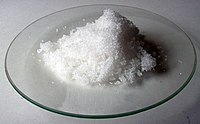
Photo from wikipedia
Background Vegetables are the most important source of nitrates in the human diet. During various processes in the body, nitrates are converted into nitrites, which causes various diseases, such as… Click to show full abstract
Background Vegetables are the most important source of nitrates in the human diet. During various processes in the body, nitrates are converted into nitrites, which causes various diseases, such as blue baby syndrome and cancer. This study aimed to determine the concentration of nitrates in several vegetable farms in Sanandaj city and to evaluate their health-related risks. Methods This descriptive cross-sectional study was conducted from October 2017 to July 2018. A total of 90 samples were taken from nine farms. Soil and water sampling was also carried out. All stages of sample preparation and extraction were carried out according to Food Standards 2–16721, and the nitrate measurements were performed using ion chromatography (Compact IC Plus 882 Model, Metrohm, Switzerland). A health risk assessment was performed using the non-carcinogenic risk assessment. Results This study’s results showed that the nitrate concertation in all vegetables was less than National Iranian Vegetable Nitrate Standard. Nitrate levels in leafy vegetables were higher than in root vegetables, and the root vegetables levels were higher than those in Fruit vegetable. The nitrate level in vegetables in autumn was higher than in spring. The cooking process reduced the raw vegetables’ nitrate content from 4.094% to 13.407%, while the frying process increased the vegetables’ nitrate content from 12.46% to 29.93%. The highest health risk level in raw, cooked and fried vegetables was parsley, parsley and beet leaves, respectively, and the lowest in all categories was tomatoes. Generally, the highest health risk was related to fried beet leaves, and the lowest was raw tomatoes. In addition, each of the abovementioned relationships between vegetables’ nitrate levels and the harvest season, type of processing procedure and type of vegetables was significant (p < 0.05). The irrigation water’s nitrate concentration in all fields was between 12.36 and 33.14 mg/l. The soil contained nitrate levels of between 4.35 and 9.7 mg/kg. Conclusion Based on this study, we can conclude that the amount of nitrates in raw vegetables was lower than the standard limit’s level and that this level does not cause health problems for consumers.
Journal Title: PLoS ONE
Year Published: 2020
Link to full text (if available)
Share on Social Media: Sign Up to like & get
recommendations!